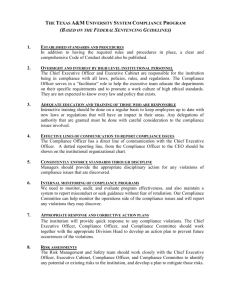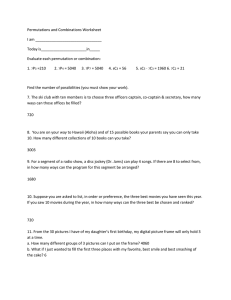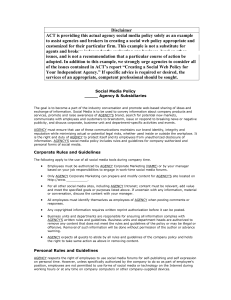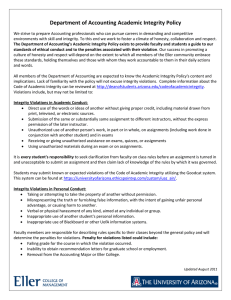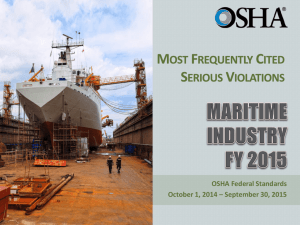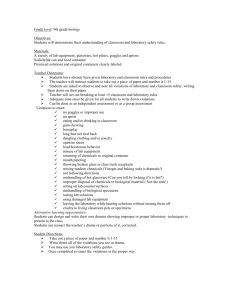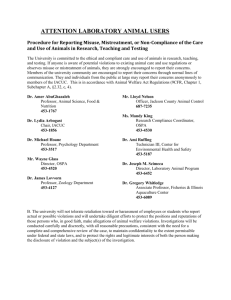Synopsis: Corporate Compliance Programs: More than a Footnote
advertisement
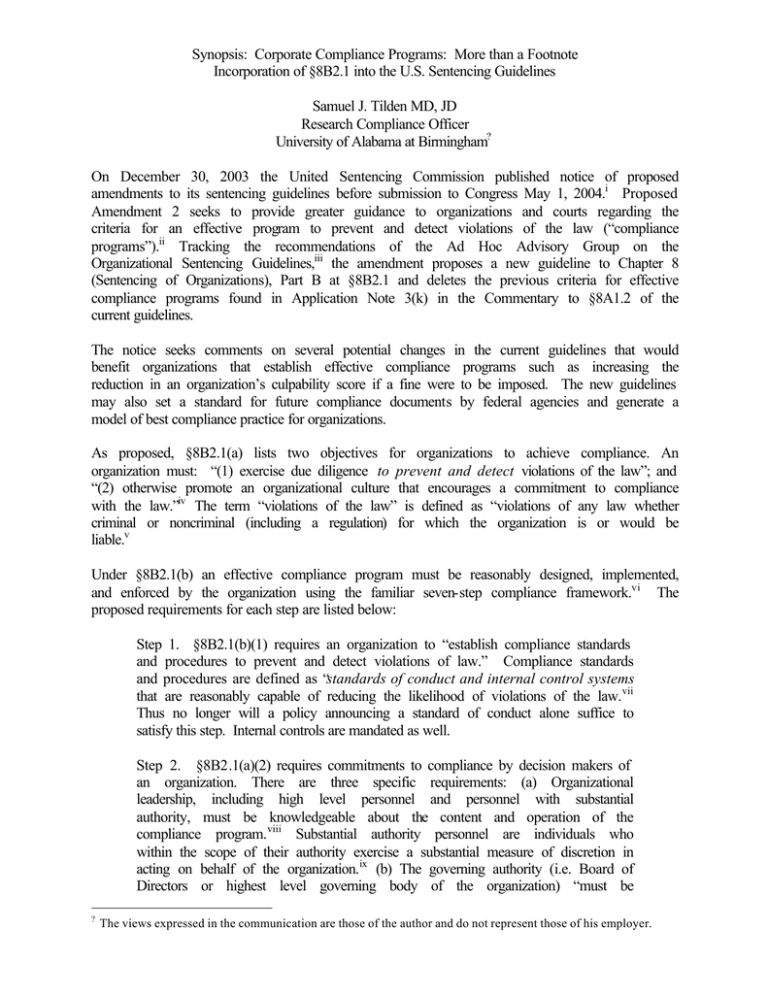
Synopsis: Corporate Compliance Programs: More than a Footnote Incorporation of §8B2.1 into the U.S. Sentencing Guidelines Samuel J. Tilden MD, JD Research Compliance Officer University of Alabama at Birmingham? On December 30, 2003 the United Sentencing Commission published notice of proposed amendments to its sentencing guidelines before submission to Congress May 1, 2004.i Proposed Amendment 2 seeks to provide greater guidance to organizations and courts regarding the criteria for an effective program to prevent and detect violations of the law (“compliance programs”).ii Tracking the recommendations of the Ad Hoc Advisory Group on the Organizational Sentencing Guidelines,iii the amendment proposes a new guideline to Chapter 8 (Sentencing of Organizations), Part B at §8B2.1 and deletes the previous criteria for effective compliance programs found in Application Note 3(k) in the Commentary to §8A1.2 of the current guidelines. The notice seeks comments on several potential changes in the current guidelines that would benefit organizations that establish effective compliance programs such as increasing the reduction in an organization’s culpability score if a fine were to be imposed. The new guidelines may also set a standard for future compliance documents by federal agencies and generate a model of best compliance practice for organizations. As proposed, §8B2.1(a) lists two objectives for organizations to achieve compliance. An organization must: “(1) exercise due diligence to prevent and detect violations of the law”; and “(2) otherwise promote an organizational culture that encourages a commitment to compliance with the law.”iv The term “violations of the law” is defined as “violations of any law whether criminal or noncriminal (including a regulation) for which the organization is or would be liable.v Under §8B2.1(b) an effective compliance program must be reasonably designed, implemented, and enforced by the organization using the familiar seven-step compliance framework.vi The proposed requirements for each step are listed below: Step 1. §8B2.1(b)(1) requires an organization to “establish compliance standards and procedures to prevent and detect violations of law.” Compliance standards and procedures are defined as “standards of conduct and internal control systems that are reasonably capable of reducing the likelihood of violations of the law.vii Thus no longer will a policy announcing a standard of conduct alone suffice to satisfy this step. Internal controls are mandated as well. Step 2. §8B2.1(a)(2) requires commitments to compliance by decision makers of an organization. There are three specific requirements: (a) Organizational leadership, including high level personnel and personnel with substantial authority, must be knowledgeable about the content and operation of the compliance program.viii Substantial authority personnel are individuals who within the scope of their authority exercise a substantial measure of discretion in acting on behalf of the organization.ix (b) The governing authority (i.e. Board of Directors or highest level governing body of the organization) “must be ? The views expressed in the communication are those of the author and do not represent those of his employer. knowledgeable about the content and operation” of the compliance program and “shall exercise reasonable oversight with respect to the implementation and effectiveness” of the compliance program.x (c) Specific individual(s) within highlevel personnel of the organization shall be assigned direct, overall responsibility to ensure the implementation and effectiveness of the program. Such individuals shall be given adequate resources and authority to carry out such responsibility and report directly to the governing authority or one of its subgroups.xi Step 3. An organization “shall use reasonable efforts and due diligence not to include any individual as substantial authority personnel if the organization knew, or should have known, that he/she has a history of engaging in violation(s) of the law.”xii For this step, violations of the law refers to some official determination of a violation of a criminal or noncriminal law including a regulation.xiii Step 4. Compliance training is required under §8B2.1(b)(4) and extends to all levels of the organization. The training must include communication via practical mechanisms of its compliance standards and procedures, the compliance program, and appropriate information concerning individual respective roles and responsibilities. In addition to employees and agents, the appropriate training extends to members of the governing authority and the organization’s leadership.xiv Step 5. §8B2.1(b)(5) requires organizations to reasonably assess organizational conduct with respect to compliance standards and respond appropriately. This step requires reasonable action to develop a system for the organization’s employees and agents to report or seek guidance regarding potential or actual violations of law without fear of retaliation and including anonymous reporting mechanisms. The organization must monitor and audit itself to prevent and detect violations of law. Also the organization must periodically evaluate the effectiveness of the compliance program.xv Step 6. §8B2.1(b)(6) requires the organization to promote and consistently enforce the compliance program through appropriate incentives to perform in accordance with the program and disciplinary measures for engaging in violations of law and for failing to take reasonable steps to prevent or detect violations of law.xvi Step 7. Under §8B2.1(b)(7) when a violation of law is detected, the organization must take reasonable steps to respond appropriately to the violations of law, including any necessary modifications to the organization’s compliance program.xvii §8B2.1(c), the final element of due diligence, requires ongoing risk assessments by the organization to implement the seven steps above. The application notes to the proposed guidelines state that an organization’s failure to incorporate within its compliance program any standard required by an applicable government regulation weighs against a finding of an effective compliance program under the guidelines. Furthermore the guidelines expect hiring or promotion to positions of leadership or substantial authority to properly reflect the organization’s commitment to a culture of compliance with the law. In addition risk assessments must be performed 2 periodically and the compliance program must focus on the most serious and likeliest risks and modify the compliance program to reduce those risks. These new guidelines are a significantly “beefed” up version of the current ones and will require all organizations that plan to meet these new criteria to outwardly embrace, commit to, and articulate the adoption of these goals. What is unknown is whether the incorporation of these new guidelines will generate any tangible or even intangible benefits for organizations or create more respect for activities performed using federal funds at extramural sites such as universities and, therefore, result in better stewardship of such funds, or rather will they serve as relatively ineffective but mandated costs of doing business in a highly regulated environment with government intervention still playing a prominent role. The answer is yet to come. i 68 FR 75340 68 FR 75356 iii www.ussc.gov/corp/advgrprpt/advgrprpt.htm visited 02/02/2004 iv 68 FR 75356 v 68 FR 75357 vi Id. vii Id. viii 68 FR 75356, 75357 ii ix 68 FR 75357; US Sentencing Guidelines, Commentary to §8A1.2 at Application Instructions – Organizations. 69 FR 75356 xi Id. xii 68 FR 75357 xiii 68 FR 75358 xiv 68 FR 75357 xv Id. xvi Id. xvii Id. x 3
